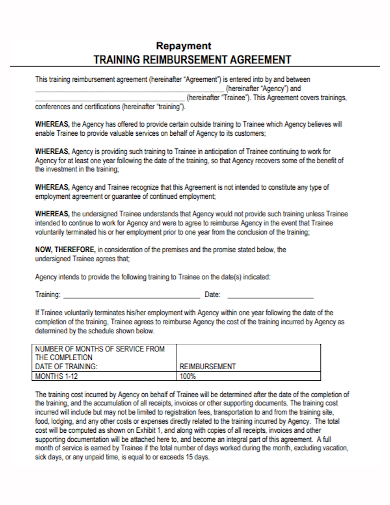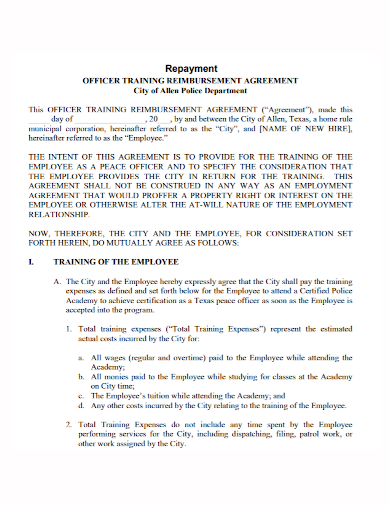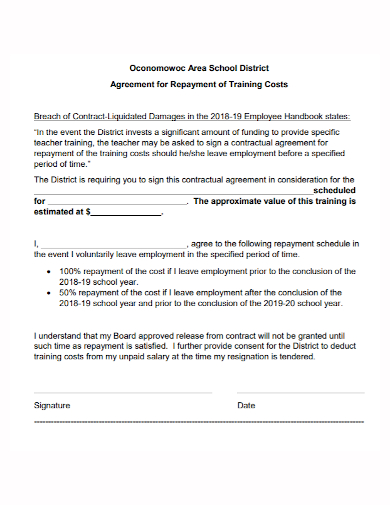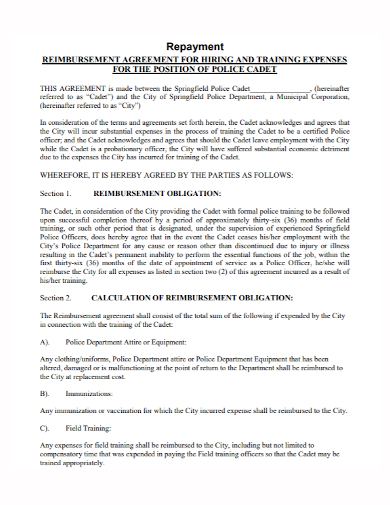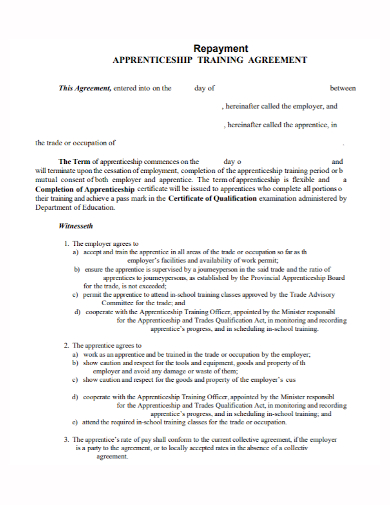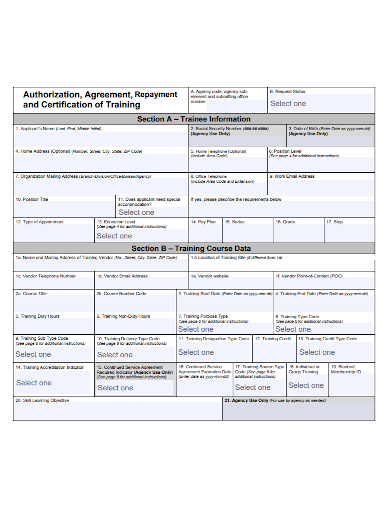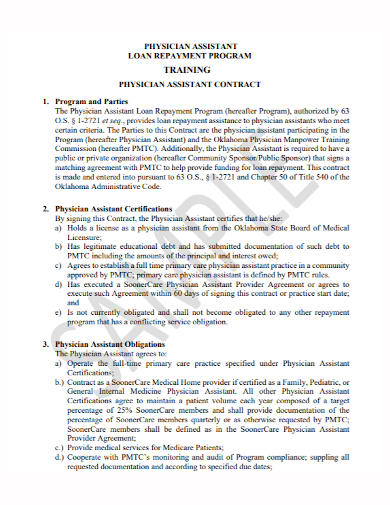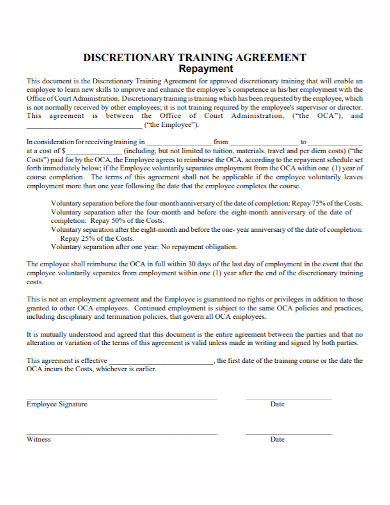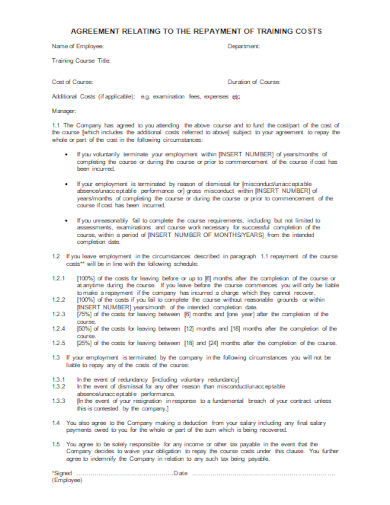Employers may be able to reclaim money spent on training an employee (for example, sending the employee to training events or workshops) if the employee leaves soon after receiving the training. ‘Training cost reimbursement’ clauses can be inserted into employment contracts, internship contracts, or apprenticeship agreements for this purpose. It is critical that these clauses be properly drafted in order for them to be enforceable. Employers can also make a separate agreement with the employee in question or include a training cost reimbursement policy in their employee contracts.
10+ Training Repayment Agreement Samples
A ‘cost-of-training-repayment’ agreement can help to mitigate the risk. This could be a stand-alone agreement or a part of an employee’s employment contract. It basically says that if an employee leaves within a certain amount of time, they must pay back the training costs. There is no way this is a penalty clause. It’s critical that the clause only applies to recouping the Company’s actual expenses, and that it’s not there to punish employees for leaving.
1. Training Repayment Agreement Template
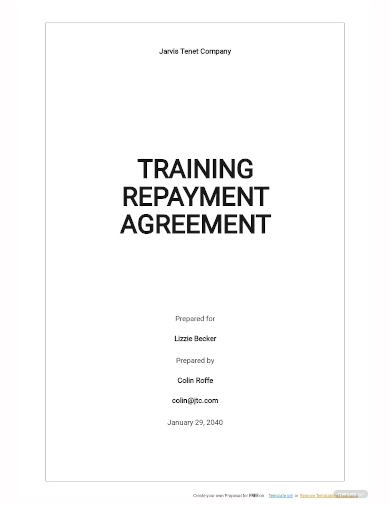
2. Training Reimbursement Repayment Agreement
3. Employee Training Repayment Agreement
4. Officer Training Repayment Agreement
5. School Training Repayment Agreement
6. Training Expenses Repayment Agreement
7. Apprenticeship Training Repayment Agreement
8. Authorization Training Repayment Agreement
9. Loan Training Repayment Program Agreement
10. Discretionary Training Repayment Agreement
11. Employee Training Costs Repayment Agreement
Requirements of Validity
To avoid the clause being unenforceable, it is critical that these types of clauses are carefully drafted.
- Penalty clause – These clauses aren’t allowed to be penalty clauses. It’s critical that the clause only applies to the company’s actual expenses and isn’t used to punish employees who leave. If a clause is interpreted as a penalty, it is unenforceable.-It creates a secondary obligation that imposes a detriment on a party in the event of a contract breach (e.g., a penalty for leaving the employer), and it creates a secondary obligation that imposes a detriment on a party in the event of a contract breach (e.g., a penalty for leaving the employer).
-This obligation is excessive in comparison to any legitimate interest of the innocent party (the employee who wishes to leave employment) in the enforcement of the employment contract’s primary obligation. - Proportionality – It’s also crucial that the clause is reasonable. For example, a staggering clause could state that if an employee/worker leaves within 6 months, they must pay 100% of the costs, but after 12 months, this drops to 75%, and after 18 months, it drops to 50%. Given that the employer will have benefited from the employee’s new qualification for a certain period of time, this approach ensures that any repayment is in direct proportion to the actual costs incurred. As a result, it’s best to avoid making extravagant or unconscionable demands in these types of clauses.
- Restraint of trade – The clause should not discourage the employee from leaving, as this would be an indirect restraint of trade. Any clause that has the effect of keeping the employee in the employer’s organization for a set period of time after training or requiring repayment if the employee leaves before a certain date could potentially be considered a restraint of trade. As a result, it should be carefully drafted to avoid being challenged under this heading.
- Non-discrimination – If an employer decides to include a clause requiring reimbursement of training costs, the clause should not be applied in a discriminatory manner. For example, an employer cannot treat an employee unfairly because of pregnancy or maternity leave by suspending the time remaining under the repayment of the training clause for the time the employee is on maternity leave and not counting that time as active service.
FAQs
What are repayment of training costs clause?
Reimbursement of training costs clauses is commonly found in employment contracts. If an employee/worker leaves within a set period of time, they must reimburse the employer for the training costs, or a portion of them.
What is the benefit of repayment of training costs agreement?
A ‘cost-of-training-repayment’ agreement can help to mitigate the risk. This could be a stand-alone agreement or a part of an employee’s employment contract. It basically says that if an employee leaves within a certain amount of time, they must pay back the training costs. There is no way this is a penalty clause. It’s critical that the clause only applies to recouping the Company’s actual expenses, and that it’s not there to punish employees for leaving.
If you want to see more samples and formats, check out some training repayment agreement samples and templates provided in the article for your reference.
Related Posts
FREE 10+ Mentoring Agreement Samples In MS Word | Apple Pages | PDF
FREE 10+ Partner Agreement Samples In MS Word | Google Docs | Apple Pages | PDF
FREE 10+ Individual Agreement Samples In MS Word | Google Docs | Apple Pages | PDF
FREE 10+ Strategic Agreement Samples In MS Word | Google Docs | Apple Pages | PDF
FREE 10+ Equity Agreement Samples In MS Word | Google Docs | Apple Pages | PDF
FREE 10+ Producer Agreement Samples in MS Word | Apple Pages | PDF
FREE 10+ Grant Agreement Samples In MS Word | Apple Pages | PDF
FREE 8+ Meeting Agreement Samples in MS Word | Google Docs | Apple Pages | PDF
FREE 10+ Community Agreement Samples In MS Word | Google Docs | PDF
FREE 8+ Real Estate Option Agreement Samples in MS Word | PDF
FREE 10+ Call Option Agreement Samples In MS Word | PDF
FREE 10+ Advertising Agreement Samples In MS Word | Google Docs | Apple Pages | PDF
FREE 10+ Car Agreement Samples In MS Word | Google Docs | Apple Pages | PDF
FREE 10+ Horse Agreement Samples In MS Word | Apple Pages | PDF
FREE 10+ Option Agreement Samples In MS Word | Google Docs | Apple Pages | PDF

